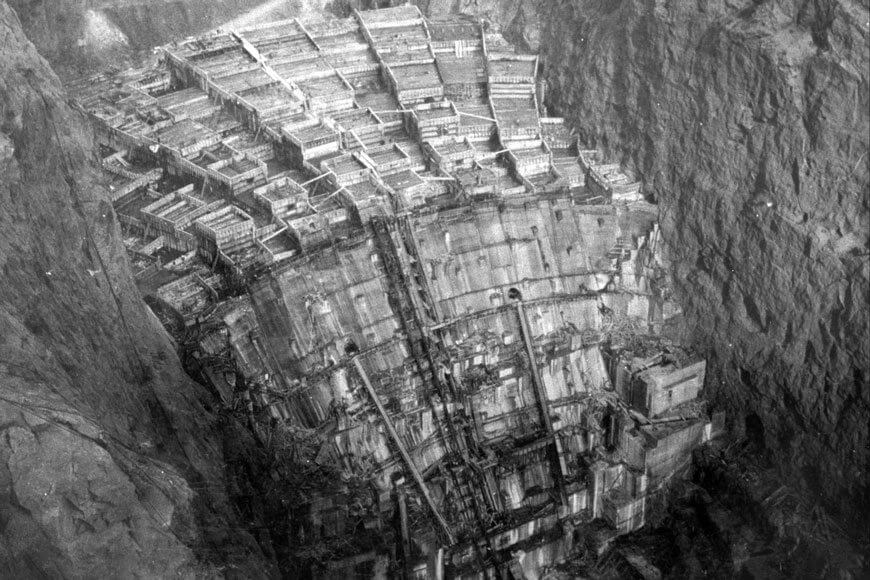From the point of view of we construction people the most interesting thing about the Hoover Dam is that it was a “first”! Never before had concrete been poured in such quantities! So here goes, how they built the hoover dam.
Now we are all vaguely aware that concrete heats and contracts as it cures, but that isn’t usually a problem on any of our jobs. For the Hoover Dam, however, it was calculated that, make it in a continuous pour, and it would take 125 years to cool and would crack and crumble! Not much use for a dam! So what happened is that it was poured in blocks up to 15 metres square and 1.5 metres high – all 2,480,000 m3 of it!
In addition, 850,000 m3 were used in the power plant and other works. More than 937 kilometres of cooling pipes were placed within the concrete. Once an individual block had cured and had stopped contracting, the pipes were filled with grout. Grout was also used to fill the hairline spaces between columns, which were grooved to increase the strength of the joints.
The concrete was made in two massive concrete plants on the Nevada side. It was delivered to site by special rail cars in steel buckets which weighed 18 tonnes when full. The buckets were then suspended from aerial cableways, which were used to deliver the bucket to a specific column.
The required size of aggregate in the concrete differed depending on placement in the dam (from pea-sized gravel to 230 mm stones) so it was vital that the bucket be maneuvered to the proper column. Once the bottom of the bucket opened up, it disgorged 6.1 m3 of concrete which was, generally, only a layer a couple of centimeters thick in that particular column.
All this was done between June 1933 and June 1935. Some going, eh? So why was it actually built? Multiple reasons: irrigation, flood prevention and hydroelectric power generation.
So now we know how the Hoover Dam was built, but that is just the end of that project! Before they could start on it they had to divert the the Colorado River away from the construction site. This required four diversion tunnels were driven through the canyon walls, two on the Nevada side and two on the Arizona side. These tunnels were 17 m. in diameter and their combined length was nearly 5 kilometers. These were started in May 1931 and completed in September 1933.
You will be Interseted to Know about – How To Solve The Biggest Problems With Construction Delay Analysis
The actual site where men would be working was further protected by the construction of two temporary coffer dams which can be seen on the sketch above. These were removed by blasting and the tunnels sealed once the Dam was completed.
The other thing which had to happen before work could start pouring concrete was to remove accumulated erosion soils from the river bed and get down to solid rock upon which the concrete columns could be placed. During this excavation, approximately 1,100,000 m3 of material was removed.
Since the dam was an arch-gravity type, the side-walls of the canyon would bear the force of the impounded lake. Therefore, the side-walls were excavated too, to reach virgin rock as weathered rock might provide pathways for water seepage. The men who removed this rock were called “high scalers”. While suspended from the top of the canyon with ropes, high-scalers climbed down the canyon walls and removed the loose rock with jackhammers and dynamite.
There are also jet flow gates which can be opened if the water level in the reservoir gets too high.
The project seemed to create shanty towns full of migrants who appeared there. One guess is that there were as many as 20,000 of them. Only about 4,000 were actually employed at any given time, though.
And below we can see what is there today which is a great tourist attraction.
At the time it cost about $60 million. That equates to something like $1.3 billion today. It was vast project, completed in 4 years. My own feeling is that the price was very cheap. I suspect there is a reason for that. It was built during the years of the Great Depression so labour costs would have been at rock-bottom, but the lads would still have been glad to be bringing any cash in!




